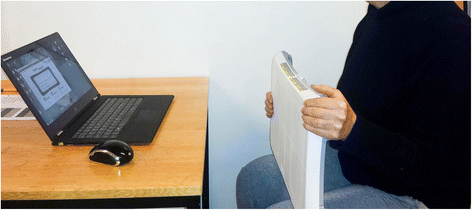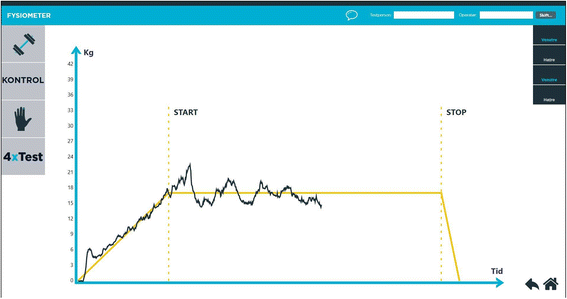Handgrip force steadiness in young and older adults: a reproducibility study
- PMID: 29609577
- PMCID: PMC5879800
- DOI: 10.1186/s12891-018-2015-9
Handgrip force steadiness in young and older adults: a reproducibility study
Abstract
Background: Force steadiness is a quantitative measure of the ability to control muscle tonus. It is an independent predictor of functional performance and has shown to correlate well with different degrees of motor impairment following stroke. Despite being clinically relevant, few studies have assessed the validity of measuring force steadiness. The aim of this study was to explore the reproducibility of handgrip force steadiness, and to assess age difference in steadiness.
Method: Intrarater reproducibility (the degree to which a rating gives consistent result on separate occasions) was investigated in a test-retest design with seven days between sessions. Ten young and thirty older adults were recruited and handgrip steadiness was tested at 5%, 10% and 25% of maximum voluntary contraction (MVC) using Nintendo Wii Balance Board (WBB). Coefficients of variation were calculated from the mean force produced (CVM) and the target force (CVT). Area between the force curve and the target force line (Area) was also calculated. For the older adults we explored reliability using intraclass correlation coefficient (ICC) and agreement using standard error of measurement (SEM), limits of agreement (LOA) and smallest real difference (SRD).
Results: A systematic improvement in handgrip steadiness was found between sessions for all measures (CVM, CVT, Area). CVM and CVT at 5% of MVC showed good to high reliability, while Area had poor reliability for all percentages of MVC. Averaged ICC for CVM, CVT and Area was 0.815, 0.806 and 0.464, respectively. Averaged ICC on 5%, 10%, and 25% of MVC was 0.751, 0.667 and 0.668, respectively. Measures of agreement showed similar trends with better results for CVM and CVT than for Area. Young adults had better handgrip steadiness than older adults across all measures.
Conclusion: The CVM and CVT measures demonstrated good reproducibility at lower percentages of MVC using the WBB, and could become relevant measures in the clinical setting. The Area measure had poor reproducibility. Young adults have better handgrip steadiness than old adults.
Keywords: Force steadiness; Handgrip steadiness; Nintendo Wii balance board; Reliability; Reproducibility.
Conflict of interest statement
Ethics approval and consent to participate
All participants gave oral consent and the protocol was reviewed and declared not mandatory for submission by the Regional Committee for Medical and Health Research Ethics in Norway (2016/1505/REK Nord).
The Regional Committee for Medical and Health Research Ethics in Norway reviewed the study protocol and declared it not mandatory for submission due to the ethically benign nature of the study. Even though the ethics committee did not need to approve the study, all participants were required to provide consent to participate in the study. Therefore, study participation was synonymous with documented consent. None of the authors had access to any personal or potentially identifying participant information. For practical purposes, and since written consent was not required, every participant provided oral consent.
Consent for publication
Not applicable
Competing interests
AWB, FE, SA and EDB declare that they have no competing interests. MGJ developed and holds a patent on the software used in the study.
Publisher’s Note
Springer Nature remains neutral with regard to jurisdictional claims in published maps and institutional affiliations.
Figures



Similar articles
-
Unilateral lower limb strength assessed using the Nintendo Wii Balance Board: a simple and reliable method.Aging Clin Exp Res. 2017 Oct;29(5):1013-1020. doi: 10.1007/s40520-016-0692-5. Epub 2016 Dec 19. Aging Clin Exp Res. 2017. PMID: 27995527
-
Isometric hand grip strength measured by the Nintendo Wii Balance Board - a reliable new method.BMC Musculoskelet Disord. 2016 Feb 3;17:56. doi: 10.1186/s12891-016-0907-0. BMC Musculoskelet Disord. 2016. PMID: 26842966 Free PMC article. Clinical Trial.
-
Novel Use of the Nintendo Wii Board for Measuring Isometric Lower Limb Strength: A Reproducible and Valid Method in Older Adults.PLoS One. 2015 Oct 7;10(10):e0138660. doi: 10.1371/journal.pone.0138660. eCollection 2015. PLoS One. 2015. PMID: 26444554 Free PMC article.
-
Can Resistance Training Improve Upper Limb Postural Tremor, Force Steadiness and Dexterity in Older Adults? A Systematic Review.Sports Med. 2019 Aug;49(8):1199-1216. doi: 10.1007/s40279-019-01141-6. Sports Med. 2019. PMID: 31236903
-
Population-specific equations of age-related maximum handgrip force: a comprehensive review.PeerJ. 2024 Jul 22;12:e17703. doi: 10.7717/peerj.17703. eCollection 2024. PeerJ. 2024. PMID: 39056055 Free PMC article. Review.
Cited by
-
Reliability of two devices for shoulder strength assessment: Wii Fit Balance Board and hand-held dynamometer.Shoulder Elbow. 2024 Mar;16(1 Suppl):110-118. doi: 10.1177/17585732221145558. Epub 2022 Dec 15. Shoulder Elbow. 2024. PMID: 38425742 Free PMC article.
-
Reference data on hand grip and lower limb strength using the Nintendo Wii balance board: a cross-sectional study of 354 subjects from 20 to 99 years of age.BMC Musculoskelet Disord. 2019 Jan 12;20(1):21. doi: 10.1186/s12891-019-2405-7. BMC Musculoskelet Disord. 2019. PMID: 30636625 Free PMC article.
-
Swallowing Pressure Variability as a Function of Pharyngeal Region, Bolus Volume, Age, and Sex.Laryngoscope. 2021 Jan;131(1):E52-E58. doi: 10.1002/lary.28667. Epub 2020 Apr 18. Laryngoscope. 2021. PMID: 32304341 Free PMC article.
-
Effect of New Zealand Blackcurrant Extract on Force Steadiness of the Quadriceps Femoris Muscle during Sustained Submaximal Isometric Contraction.J Funct Morphol Kinesiol. 2022 May 30;7(2):44. doi: 10.3390/jfmk7020044. J Funct Morphol Kinesiol. 2022. PMID: 35736015 Free PMC article.
-
Combined driving: task-specific position impacts grip strength of equestrian athletes.Eur Rev Aging Phys Act. 2022 Jan 10;19(1):2. doi: 10.1186/s11556-021-00282-w. Eur Rev Aging Phys Act. 2022. PMID: 35012451 Free PMC article.
References
Publication types
MeSH terms
LinkOut - more resources
Full Text Sources
Other Literature Sources
Medical

